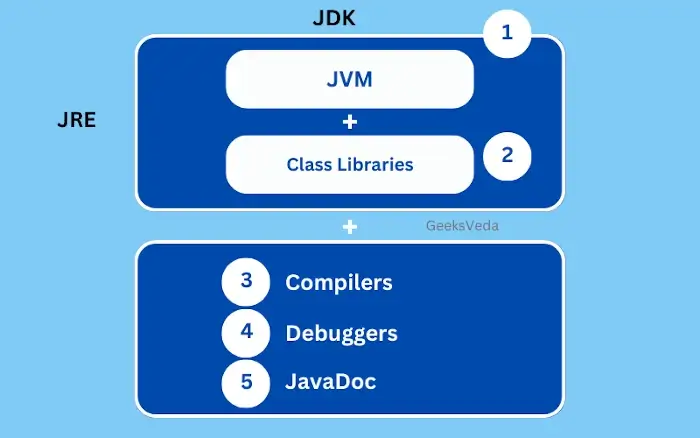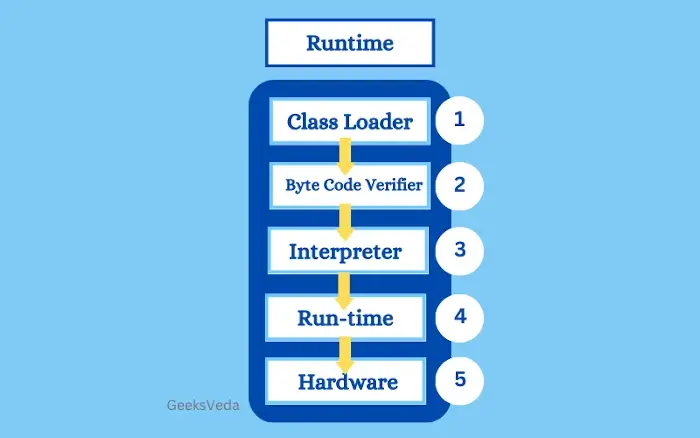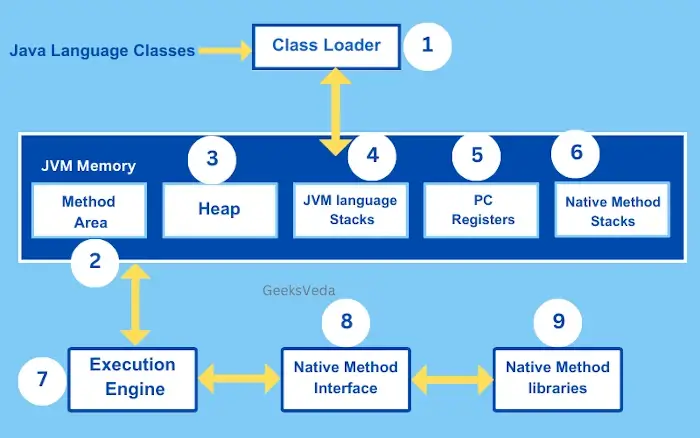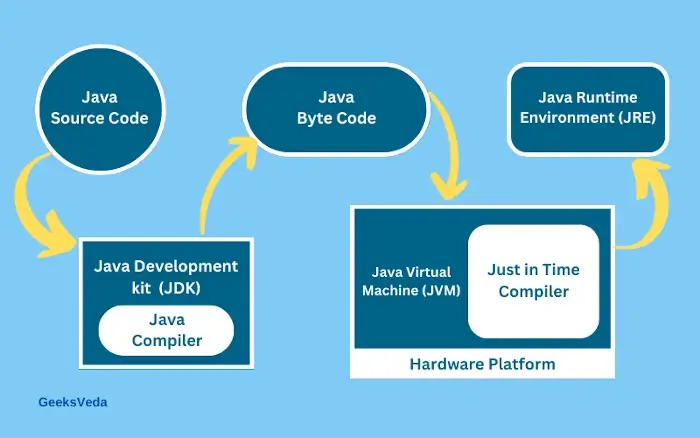Java is a widely utilized, high-level language popular for its “platform independence”. This means, when Java source code is compiled, it is converted into platform-independent bytecode, not in machine code.
After that, the bytecode can be run by Java Virtual Machine (JVM) on any system. Moreover, the Java language’s popularity and use have been embedded by tools like JDK, JRE, and JVM, which make it simpler to develop and deploy in different settings.
This guide will cover the following contents:
- What is Java Development Kit (JDK)
- What is Java Runtime Environment (JRE)
- What is Java Virtual Machine (JVM)
- Relationship Between JDK, JRE, and JVM
- Differences Between JDK, JRE, and JVM
What is JDK Java Development Kit
JDK is an abbreviation for “Java Development Kit“. It is a package of tools that programmers use to write, compile and build Java Programs. Java code written using JDK can execute or operate on any platform compatible with JVM.
Additionally, it is an essential toolkit for Java programmers that enables them to develop software solutions for various platforms.
Let’s take a closer look at some of the key features of JDK:
- Java Compiler: One of the main features of the Java Development Kit (JDK) is its ability to convert source code into “platform-independent bytecode“. This bytecode can be executed on any Java Virtual Machine, which makes it easier to develop and deploy Java applications across different platforms.
- Java Class Libraries: The JDK includes a collection of “ready-to-use Java class libraries” that provide various tools to make programming easier. The library helps with tasks, such as writing and reading files, handling network connections, and much more.
- Java Native Interface (JNI): The Java Native Interface (JNI) acts as a bridge between “Java and other programming languages”, such as
CorC++. This permits Java code to work together with code written in these languages. - Security Features: JDK comprises built-in security features, including a security manager that controls and monitors access to important parts of the computer system. These security features assist programmers create secure Java Programs and applications to “handle sensitive data” and perform safely in various environments.
- Multithreading Support: JDK enables developers to create multithreaded Java applications, which means designing programs that can perform two different functions at the same time. This has benefited most programmers because modern computers often have multiple processors, and multithreading allows the application to make use of all the processors simultaneously. This results in faster application performance and quicker response times to user interactions.

What is Java Runtime Environment
Java Runtime Environment (JRE) is a “software package” that offers runtime support to run Java programs. It acts as a bridge between compiled Java bytecode and the operating system to enable the platform.
JRE also includes an extensive collection of Java Class libraries that are required to form the Java API. Moreover, it is essential for running Java programs because it ensures that Java applications can work on various systems without any extra work needed.
JRE provides several features that ensure the efficient and secure execution of Java applications. Some of them are given below:
- Execution of Java Applications: The main purpose of JRE is to run Java programs. When you want to use a Java application, the JRE makes sure that the program can run on your computer. It “handles all technical stuff“, such as the conversion of Java code into machine language. So when you use Java Programs, its JRE helps make them run smoothly.
- Memory Management: It handles the “computer memory” for Java programs. It automatically frees up space when objects are no longer needed and ensures that memory is used efficiently. This prevents memory leaks and keeps Java applications running efficiently without memory-related issues.
- Deployment and Distribution: The JRE helps developers to “share their Java applications” with others. It can be done by bundling their Java programs into “
JAR” files, which are easy to distribute and run on other users’ computers. - Java Web Start: It is a feature that is supported by JRE so that users can easily run Java applications “directly from the internet“. Because of Webster, there is no need for manual installation, making it convenient for users to access and use Java programs online.
- High-Performance Networking: It permits Java applications to “communicate and exchange data” with other computers over the internet or local networks. It also provides tools that allow developers to create and manage connections between different machines.

What is Java Virtual Machine in Java
Java Virtual Machine (JVM) is a fundamental part of the Java Runtime Environment (JRE). It handles the execution of the Java bytecode. JVM translates the Java code into instructions that the computer can follow.
Now, let’s take a closer look at some of the key features of JVM:
- Profiling and Monitoring: It offers tools and APIs that help developers to “configure the performance of Java applications”. This monitoring process allows for identifying any performance where the application is running slowly.
- Accessibility Support: It enables developers to create applications that are more user-friendly and accessible to people with disabilities. For example, developers can use accessibility APIs to provide alternative text descriptions for images. This makes it possible for users with visual impairments to understand the content of the added pictures or images through screen readers.
- Deployment Features: It includes features that are used for “deploying Java applications” in web browsers making it easier for users to access and run Java programs.
- Class Custom Loaders: With the help of custom class loaders, developers can “define new rules for loading classes“. For instance, you can load classes from unusual places like specific folders on the computer or even from the internet from a remote source.
- Just in Time (JIT) Compiler Levels: The JIT compiler of the JVM offers various “optimization levels that developers” can select according to their application’s requirements, finding a balance between the startup time and the execution speed.

Relationship Between JDK, JRE, and JVM
Developers utilize the JDK (Java Development Kit) “to produce Java applications”, which encompasses the Java compiler and various development tools. Meanwhile, end-users require the JRE (Java Runtime Environment) “to operate Java applications”, which involves the JVM (Java Virtual Machine) responsible for “executing Java bytecode” and ensuring platform independence.
The JVM is a fundamental component that both JDK and JRE depend on to interpret and execute Java programs on various platforms.

Differences Between JDK, JRE, and JVM
Here is a simple and easy-to-understand table that highlights the difference between JDK, JRE, and JVM:
| Aspect | JDK (Java Development Kit) | JRE (Java Runtime Environment) | JVM (Java Virtual Machine) |
| Usage | For developing Java programs | For running Java applications | For executing Java bytecode |
| Components | Java compiler and tools | Java class libraries | Interpreter and JIT Compiler |
| Platform Independence | Not platform-independent | Platform-independent | Platform-independent |
| Dependency | JRE is part of JDK | None, standalone | An integral part of JDK and JRE |
| Main Purpose | Development and compilation | Runtime support | Bytecode execution |
| Target Audience | Developers and programmers | End-users | Transparent to users |
That’s all from this beginners’ guide related to Java JDK, JRE, and JVM.
Conclusion
Developers use Java JDK to create Java programs using tools, such as the compiler and libraries. Additionally, to run Java applications, JRE is required, which includes the JVM that executes Java code on any system.
Note that the JDK, JRE, and JVM work together to enable Java’s platform independence and ensure seamless development and execution of Java applications.
